March 1, 2024
Air Date: March 1, 2024
FULL SHOW
SEGMENTS
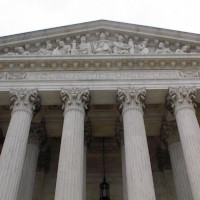
States Challenge EPA "Good Neighbor" Rule
View the page for this story
Ohio, Indiana, and West Virginia have challenged the Environmental Protection Agency’s “Good Neighbor” rule in the Supreme Court. The regulation is designed to keep one state’s ozone emissions from spilling downwind and pushing another state out of compliance. Michael Burger from the Sabin Center for Climate Change Law at Columbia University joins Host Paloma Beltran to explore what this challenge means for the environmental regulation landscape. (10:44)
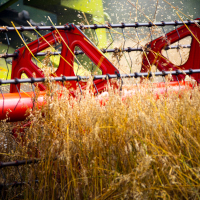
Beyond the Headlines
View the page for this story
Living on Earth contributor Peter Dykstra joins Host Aynsley O’Neill with news of a study showing a particular pesticide that’s present in 80% of U.S. adults. Then, the two discuss some 450 state bills asking for PFAS legislation on the docket in 2024. Finally, the pair take a look at some key historical moments surrounding national lands. (05:01)
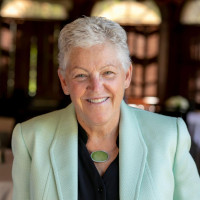
Gina McCarthy on Particulates
View the page for this story
The U.S. Environmental Protection Agency has announced new measures to reduce the allowable amount of fine particulate pollution in the air. Former EPA Administrator Gina McCarthy joins Host Aynsley O’Neill to discuss these new standards, as well as the Inflation Reduction Act and the role of women in the environmental movement. (12:38)
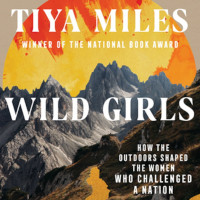
Wild Girls: How the Outdoors Shaped the Women Who Challenged a Nation
View the page for this story
To kick off Women’s History Month, we take a look at the history of women outdoors in America. From abolitionist Harriet Tubman to novelist Louisa May Alcott, some of the country’s most important women trailblazers shared a connection with the natural world in their girlhood. According to author Tiya Miles in her book Wild Girls: How the Outdoors Shaped the Women Who Challenged a Nation, this time spent in the outdoors prepared these women to become pioneers in their fields. She joins Host Paloma Beltran for more. (16:02)
Show Credits and Funders
Show Transcript
240301 Transcript
HOSTS: Paloma Beltran, Aynsley O’Neill
GUESTS: Michael Burger, Gina McCarthy, Tiya Miles
REPORTERS: Peter Dykstra
[THEME]
O’NEILL: From PRX – this is Living On Earth.
[THEME]
O’NEILL: I’m Aynsley O’Neill
BELTRAN: And I’m Paloma Beltran.
For Women’s History Month, the connection between trailblazing women and the natural world.
MILES: Harriet Tubman talked about how she was a neglected weed. She recognized the way in which she was being mistreated as a child and she also associated herself with a kind of living thing that is incredibly tough and resilient.
O’NEILL: Also, the Supreme Court considers the EPA’s “Good Neighbor” ozone rule.
BURGER: Actions like this emergency requests to stay new regulations from coming into effect participate in this broader trend which is using the courts and using the law to stifle regulatory action rather than to promote environmental protection.
O’NEILL: That and more this week on Living on Earth. Stick Around!
[NEWSBREAK MUSIC: Boards Of Canada “Zoetrope” from “In A Beautiful Place Out In The Country” (Warp Records 2000)]
[THEME]
States Challenge EPA "Good Neighbor" Rule
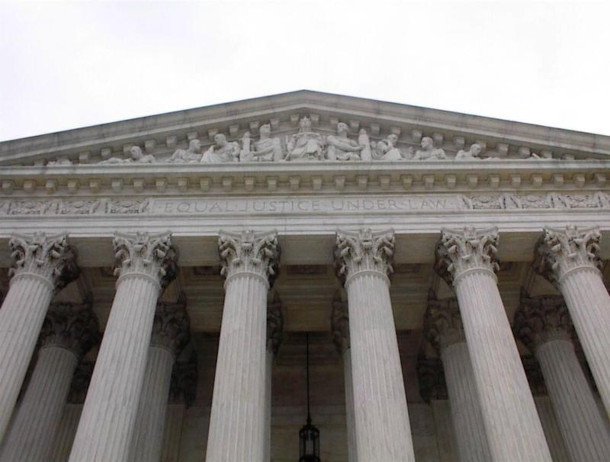
The U.S. Supreme Court heard oral arguments regarding the EPA’s “good neighbor” ozone rule on February 21, 2024. This was part of the Court’s “shadow docket”, as it was filed as an emergency appeal. (Photo: Wikiwopbop, Wikimedia Commons, CC BY-SA 2.5)
O’NEILL: From PRX and the Jennifer and Ted Stanley Studios at the University of Massachusetts, Boston this is Living on Earth. I’m Aynsley O’Neill.
BELTRAN: And I’m Paloma Beltran.
Three energy producing states are arguing the EPA should be blocked from implementing an anti-pollution rule before the courts have a chance to rule on it, and in what would be a largely unprecedented ruling, the US Supreme Court appears poised to go along. On February 21st the high Court held oral arguments on an update of the EPA's so-called “Good Neighbor” rule that would tighten up measures designed to keep toxic smog in one state from pushing another state out of compliance. Regulations are often challenged in court, but the Supreme Court rarely handles them on an emergency basis. Ground-level ozone, also known as smog, is tied to a variety of health issues including increased respiratory illnesses, reproductive concerns, and cancers. But 115 million Americans now live in states where smog exposure exceeds legal limits--with the bad air often coming from upwind jurisdictions. So, the EPA’s “good neighbor” plan includes a failsafe measure – if these “upwind” states submit ozone emissions plans that are not up to snuff, then the EPA is required to step in. But last year, after EPA rejected the proposals of 23 states and created a federal enforcement plan, three states and a number of industry and trade groups challenged it, though it would be years before the most important parts of the measures would go into effect. As this case progresses, experts are noting comparisons to the 2022 case West Virginia vs. EPA, where the Supreme court preempted the agency’s options for regulating power plant emissions. Joining us now for more is Michael Burger, Executive Director of the Sabin Center for Climate Change Law at Columbia University. Michael, welcome back to Living on Earth!
BURGER: Thanks. It's great to be back.
BELTRAN: So this case was brought forward by three states, Ohio, Indiana and West Virginia, along with several companies and industry groups as an emergency action. What's their argument here? And how common is this sort of petition at the Supreme Court level?
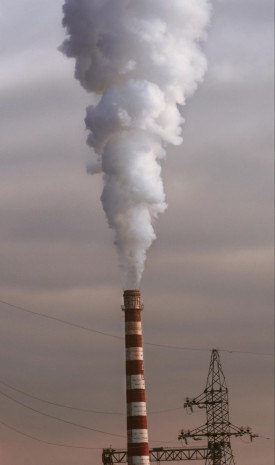
Emissions from factories are one of the pollution sources addressed by the EPA’s Good Neighbor plan, which is up for review by the Supreme Court. (Photo: Grigoriy, Pexels, CC)
BURGER: Well, it is important to note that they brought it as an emergency action. So we're not dealing with your typical case that's before the Supreme Court that's been fully briefed by the parties, and where the merits of the case itself are what's before the court. What's before the court here is a motion to stay the federal rule while the litigation happens at the court of appeals below. And the argument that the states are making here is that because they will incur costs in the short term, in order to start to begin to come into compliance with the requirements that the rule sets forth, a couple of years down the line, the rules should be stayed while they're able to litigate the merits. And this type of argument is frequently raised by entities that are newly subject to regulation by regulated industries, and by states that are opposed to new regulations. What's different here is that the Supreme Court appears to be seriously considering staying the rule, even when the court below, when the DC Circuit Court of Appeals denied the very same motion.
BELTRAN: And, Michael, from what I understand, this isn't the only case that's dealing with the “Good Neighbor” plan.
BURGER: That's correct. There are a number of cases in different courts of appeals. Some of the cases are challenging EPA's rejection of the state plans. And then this case is challenging the EPA's plan itself. So you know, the outcome of this case will affect the other cases, but it's a little bit messy, what's going on in the lower courts. And we'll just have to wait and see what happens.
BELTRAN: And to what extent do you see this challenge in the courts as a parallel to the West Virginia vs. EPA case from 2022?
BURGER: In some ways, it strikes me as the Clean Power Plan 2.0. I mean, in that case, the Supreme Court, Justice Scalia reached down and stayed the Clean Power Plan while litigation was happening below. And that was really the first time that the Supreme Court had taken that kind of action. And here, there seems to be the risk that we'll see a repeat.
BELTRAN: So if the Supreme Court does sign against the EPA rule here, what's next?
BURGER: If the Supreme Court rules against EPA here, it won't be ruling against the rule per se. What they'll be determining is whether the rule should be stayed from going into effect or whether it should be enjoined from going into effect while the merits of the rule, the legality of the rule is litigated in the DC Circuit Court of Appeals. So you know, EPA's arguing here that that should not happen that well established precedent requires a very high bar for petitioners to satisfy and that here, the simple fact that they have to come into compliance or begin to come into compliance with the requirements is just not enough. If you think about it, that argument would apply in pretty much any circumstance in which a new federal rule comes into effect. Any party subject to new regulation could argue that it is going to incur some costs, while it challenges the rule. And we could find ourselves in a situation where pretty much most or even all major federal regulatory actions are put on hold while the courts figure out whether or not the courts are satisfied that they're legal. So here, if the rule is stayed, then the existing rules would remain in effect, and EPA would be somewhat stymied by the courts in its efforts to clean up the air and promote human health.
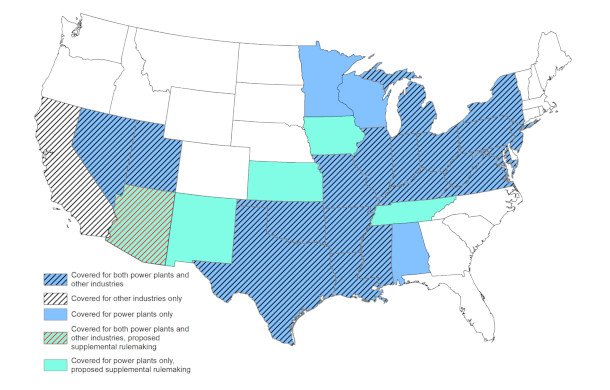
Because pollution easily travels across state lines, “downwind states” need the good neighbor rule to meet federal ozone standards, so they aren’t affected by the “upwind” states’ behavior. Shown here is the EPA’s graphic titled “States Covered Under the Final Good Neighbor Plan and the Proposed Supplemental Rulemaking”. (Photo: Environmental Protection Agency)
BELTRAN: And in the meantime, the states would still keep the ozone emissions before the update on this “Good Neighbor” plan.
BURGER: Right, it's not a "Wild West" situation. There are standards in place, and there are plans in place for compliance with the “Good Neighbor” provision of the Clean Air Act, and those rules would continue to apply, even if this one gets held up.
BELTRAN: Michael, why does this case matter?
BURGER: Because we're before the court here on an emergency action. What's at stake here is less the ultimate outcome of the case, where the challenge to the EPA's “Good Neighbor” plan, and more kind of how the court and the courts are going to operate in relationship to new federal rules and new federal regulations. The real risk here is that if the court enjoins this rule from going into effect, just because regulated entities incur costs, in order to start to come into compliance with the terms of the rule, that argument could apply in pretty much any circumstance. And so we might well find ourselves in a situation where federal agencies are really held back in their ability to provide environmental and public health and consumer protections, while litigants challenge things in court.
BELTRAN: Well, Michael, we can't really predict what will happen. But let's look into your crystal ball. How do you think this case might impact how the Supreme Court behaves in the future?
BURGER: If the Supreme Court does decide to enjoin the rule at this stage, it would be a unusual move. You know, it's not the usual trajectory for litigation in the federal courts to get to the Supreme Court and to have a major federal rule like this, you know, stopped, while it gets litigated in the courts below. The law has developed over half a century or more to sort of protect against that, precisely because we do not want our government to be held up every time it tries to pass a new regulation, forced to wait for the courts to determine whether or not what it has done is legal. That is the reverse of how we want our separation of powers to operate. So, you know, in this particular instance, we are looking at a situation where if the court goes the route that many observers feel it is likely to go, we'll be looking at another instance of this court taking highly unusual action for what appeared to be ideological or even political reasons.
BELTRAN: Now you spent your career working in the environmental and climate law world. How do you react to a challenge like this at the level of the Supreme Court?

Michael Burger is the Executive Director of the Sabin Center for Climate Change Law. (Photo: Columbia University)
BURGER: Well, I think consistent with other action that we're seeing in the Supreme Court, and in some of the courts of appeals, the risk here seems to be part and parcel of a broad-based attack on the so called administrative state, on the power of federal agencies to take significant action to address contemporary problems of public health, the environment and other matters. You know, the willingness of some justices to block federal action at a very early stage, even before the courts below have ruled on it, which is quite simply an unusual move in our court system, it's surprising. It's not absolutely surprising, because we have seen it before, but it doesn't bode well for the ability of federal government to address emerging and well established environmental and public health problems. And I should also say, we don't have a decision on this case yet, of course. You know, there is some tea leaf reading going on here based on what happened at the oral argument. So while it does seem likely that the court may well enjoin the EPA in this case, we don't know yet, that that's what's going to happen.
BELTRAN: To what extent do you worry about the future of environmental regulation in this country with so many rules being challenged in the courts? Where do you think we're headed?
BURGER: Well, I think that I like plenty of others, though not everyone, am quite concerned about the prospects for ambitious federal action under the current Supreme Court. And in the current state of the courts of appeals as well, at least in in certain courts of appeals, there does seem to be a ideological opposition to regulatory action by the federal government that is driving some of the doctrines that we are seeing emerging from the court and actions like this, emergency requests to stay new regulations from coming into effect, participate in this broader trend, which is using the courts and using the law to stifle regulatory action rather than to promote environmental protection. So if the court goes the wrong way here, I think it'll be a real cause for concern.
BELTRAN: Michael Burger is the Executive Director of the Sabin Center for Climate Change Law at Columbia University. Thanks for taking the time with us today.
BURGER: Thank you.
Related links:
- Learn more about the EPA’s Good Neighbor plan
- Learn more about the negative effects of ozone
- Michael Burger at the Sabin Center for Climate Change Law
[MUSIC: Enrique Eisenmann, “Niños Peruanos” on The Free Poetics of Enrique Eisenmann, by Enrique Eisenmann, Red Piano Records]
O’NEILL: Coming up, why the EPA is often known as the “She” PA. That’s just ahead, stay tuned to Living on Earth!
ANNOUNCER: Support for Living on Earth comes from Sailors for the Sea and Oceana. Helping boaters race clean, sail green and protect the seas they love. More information @sailorsforthesea.org.
[CUTAWAY MUSIC: PSA Trio, Pritesh Walia, Sharik Hasan, Avery Logan “Cliff Dunes” on PSA, PSA Records & Production ltd.]
Beyond the Headlines
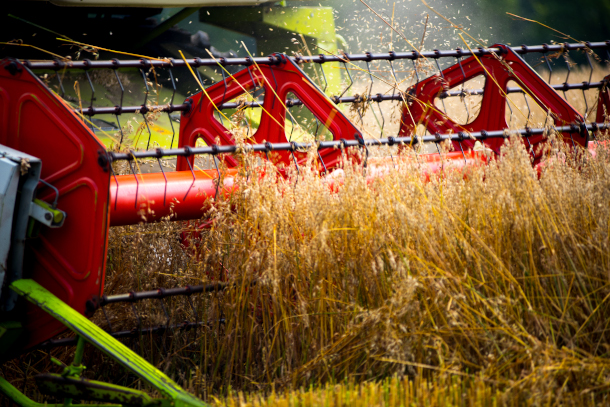
Chlormequat is applied to crops like oats to prevent them from drooping and make them easier to harvest. However, animal studies suggest that it may have harmful health effects related to fertility and fetal development. (Photo: Tim Jokl, Flickr, CC BY-NC 2.0)
BELTRAN: It’s Living on Earth, I’m Paloma Beltran.
O'NEILL: And I'm Aynsley O'Neill.
And it's time now in the broadcast for a check in with Peter Dykstra. Peter is a contributor to Living on Earth and he looks beyond the headlines for us. He's on the line now from Atlanta, Georgia. Hi, Peter. What do you have for us this week?
DYKSTRA: Hi, Aynsley. first story is about a new pesticide to worry about, oh, joy: chlormequat. There had been previous animal studies that found chlormequat to potentially impact reproduction, weight, and bone development. There's a study done by scientists at an interest group, the Environmental Working Group, that was published in a peer reviewed journal, Journal of Exposure Science and Environmental Epidemiology. The study is the first one done in the US on adults, and 80% of those tested had chlormequat in their urine.
O'NEILL: 80% is kind of a lot, Peter. What is this pesticide and where is it found?
DYKSTRA: It's used in some ornamental plants, but also it's used in imported grains like wheat, oats, and barley. Those grain crops grown in the US, chlormequat is not allowed. And here's the thing. It's not what you normally think of as a pesticide that kills weeds or kills bugs. Chlormequat slows the growth of the stems, keeps the crops from bending over and makes harvesting easier. We'll have to see if further research confirms that it's a risk for humans.
O'NEILL: We'll have to keep an eye on it, Peter. What else do you have for us this week?
DYKSTRA: Here's a report domestically and more politically about PFAS, those so called "forever chemicals." The group Safer States found that this could be a big year for PFAS legislation on the state level, also other toxic chemicals. 36 states have more than 450 bills up for consideration on toxic chemicals. PFAS with all of the suspected health risks and confirmed health risks are high on the list as well. So going to be a good year to watch and see what happens with chemical legislation in more than two thirds of our states.

36 states will soon consider more than 450 bills related to toxic chemicals and plastics, according to an analysis by Safer States. (Photo: martin gautron, Flickr, CC BY-NC 2.0)
O'NEILL: Peter, we talk about these forever chemicals so much on the show. It feels pretty good to see almost 500 different bills all working to maybe reduce some of these toxic chemicals in our world.
DYKSTRA: But they're only bills, they have to be passed and signed. And we'll see in each of those 36 states how far that process gets.
O'NEILL: Yeah. And to find out whether your state is or isn't looking at these toxics go to our website, loe.org. But before we let you go, Peter, it is time for a history lesson.
DYKSTRA: Yeah, we have a doubleheader on trees. Going back to March 1, 1911. The Week's Act was signed by President Taft in response to major threats to forests in the Eastern US. The Weeks Act, sponsored by Congressman John Weeks of Massachusetts authorizes the purchase of land for national forests and the protection of watersheds and also supports fire protection efforts. On the other hand, Congressman and later Senator Weeks was a strict opponent of women's suffrage.
O'NEILL: Well, that's a bit of a trade off Peter, especially with women's history month. But what is the other story you've got for us, Peter?
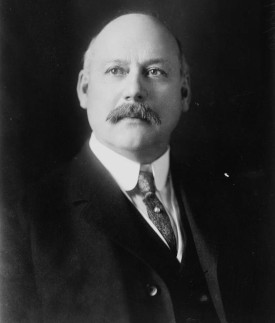
The Weeks Act, sponsored by Congressman John Weeks of Massachusetts and signed by President Taft in March 1911, authorized the purchase of land for national forests and the protection of watersheds, and supported fire protection efforts. Unfortunately, Weeks was also a strict opponent of women's suffrage. (Photo: George Grantham Bain, Wikimedia Commons, no known copyright restrictions)
DYKSTRA: It's from early March 1966. A widely held misquote from future president, California gubernatorial candidate Ronald Reagan. He's always said to have said, "If you've seen one tree, you've seen them all." What is believed to be the correct quote, not much better in terms of environmental values, Reagan said in an interview in the Sacramento Bee and also in a public speech about expanding Redwood National Park in California, quote, "A tree is a tree. How many more do you need to look at?"
O'NEILL: Well, thank you for bringing us both these pieces of history, Peter, but you are missing a key historical event that we absolutely must cover here at Living on Earth. March 2, 1957, environmental historian and King of snark himself, Peter Dykstra is born in Hackensack, New Jersey.
DYKSTRA: Let's go Jersey!
O'NEILL: Let's go Jersey! Peter Dykstra is a contributor to Living on Earth and we will talk to you again real soon.
DYKSTRA: All right, Aynsley. Thanks a lot. Talk to you soon.
O'NEILL: And Happy Birthday!
DYKSTRA: Thank you!
O'NEILL: And there's more stories on the Living on Earth webpage, that's loe.org.
Related links:
- Read the study about chlormequat in food and urine samples:
- Find out which states are considering bills related to toxic chemicals and plastics:
- Learn more about the Weeks Act:
- Check out the Snopes.com investigation of the famous Reagan quote (actually a paraphrase): “If you’ve seen one tree, you’ve seen them all”:
[MUSIC: Blue Deputy, “New Jersey” Single, Fault Records]
Gina McCarthy on Particulates
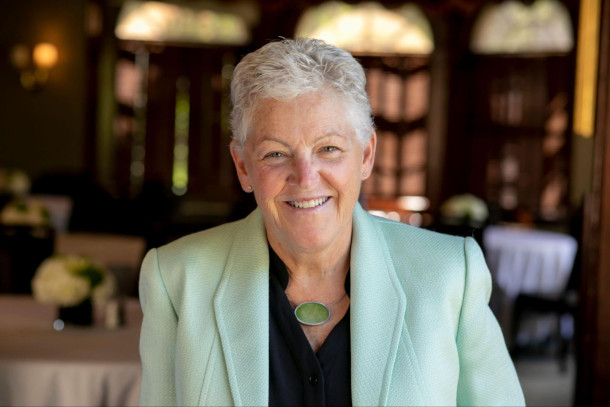
Gina McCarthy was the Administrator for the Environmental Protection Agency from 2013-2017 and the first White House National Climate Advisor from 2021-2022. She is now the Managing Co-Chair of America Is All In. (Photo: Harvard University)
O’NEILL: Some of the most common pollutants in our air are ultra-fine particles known as PM 2.5. These tiny particles are mostly emitted during the combustion of solid and liquid fossil fuels, like coal and gasoline. Inhalation of these tiny particulates can have adverse health impacts like cardiovascular disease and asthma. Recently the U.S. Environmental Protection Agency announced that it is reducing the allowable amount of fine particulate matter in the air. This update of a decade-old rule lowers PM2.5 from 12 micrograms per cubic meter to 9 micrograms per cubic meter. EPA experts hope this decision will lessen the negative health effects associated with exposure to PM 2.5, which is often felt most brutally in low-income communities where industrial and other high-emission facilities are clustered. Among the supporters of this rule is Gina McCarthy, former Administrator of the Environmental Protection Agency as well as the first White House national climate advisor. Here’s what she had to say about the importance of reducing particulate matter pollution:
MCCARTHY: I spend a great deal of my time trying to get people to really genuinely focus on the intersect of air quality and climate change because both of them are really the result of our dependence on fossil fuels. Because that is what is contributing to the air quality challenges across the world.
O’NEILL: Gina McCarthy is currently the Managing Co-Chair of “America Is All” In and she joins us now for more. Welcome back to the show, Gina!
MCCARTHY: It's great to be here. Thanks so much.
O'NEILL: What exactly has the EPA changed here when it comes to particulate matter pollution?
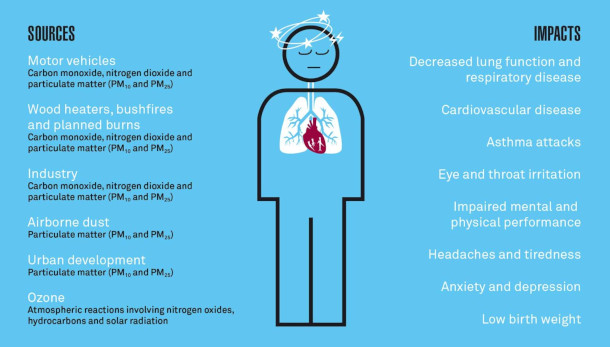
Exposure to PM2.5 pollution poses a number of health hazards including increased cardiovascular disease, asthma, and poor birth outcomes. (Photo: Office of the Commissioner for Sustainability and the Environment Australia, ScienceBorealis.ca, CC-BY-3.0)
MCCARTHY: Well, I think they took a close look at the regulatory standards that were in place to try to reduce particulate matter in particular, the PM 2.5, which is very small, and very impactful on health. And they took a close look at it. And they brought their scientists together, and they decided that they need to tighten that standard in order to protect both health and welfare. And so I'm excited about it, frankly, because I don't think people realize just how impactful air pollution is. I know that folks are looking at the premature deaths in the US, which is somewhere, I guess, in the order of 350,000. But honestly, if you take a look across the world, we're talking about 7 million premature deaths across the world. And if you look at the impacts from the climate disasters that we've been seeing, that far surpasses a couple of million people every year. And so we are facing some real challenges. And it's important to understand that EPA's job is to reduce those emissions as much as it can, under the law. And tightening the PM standard is a significant opportunity to get emissions down and to save literally thousands, if not millions of lives.
O'NEILL: Well so what are some of the health impacts? How are these strengthened standards going to better protect the communities across America?
MCCARTHY: Well, particulate matter impacts not just certainly air quality. It impacts human health in a variety of ways. Obviously, if you're breathing in PM 2.5, you could have lung damage, impacted breathing, asthma, but it goes well beyond that. It also impacts your heart and your vascular system. So we are talking about impacts that are particularly focused on young people, on people with other disabilities. These are challenges that are stealing and robbing lives early, rather than letting people live healthy lives. PM 2.5, make no mistake, the 2.5 is how big the particle is. And so when we're looking at PM 10, you're looking at a less challenging pollutant, because it doesn't quite go into your body in the same way that those small particles can, which means they are probably doing far more damage to your body than the damages that we can identify. But it's associated with debilitating diseases, and premature death, which I think is all any of us should need to know that we should get rid of it.

The Inflation Reduction Act mobilizes billions of dollars in investments in clean energy and the transition away from fossil fuels. (Photo: Kervin Edward Lara, Pexels, CC)
O'NEILL: I want to take a look at this from an economic side. Because clearly particulate matter pollution impacts air quality, it impacts human health. But in what ways does it impact our economy? How does it hurt economic growth?
MCCARTHY: We now know, on the basis of this rulemaking, that we have significant, millions of dollars in benefits that will result from this change in regulation. And so I'm excited about the opportunities that it's showing to make our lives better, and to have those put into raw data on what it means for human beings and our economy. And so the interesting thing about a lot of the changes that we're seeing today in the tightening of regulations is that we can not only, you know define it in cold hard cash, if you will. But we can also define it in terms of illnesses that have been reduced. And we can put not just numbers on this, but faces on it. We know the communities that will be better off as a result of these changes.
O'NEILL: Gina, you're the Co-Chair of “America Is All In”. Please tell us a little bit about that organization and the kind of projects that it works on.
MCCARTHY: Well, “America Is All In” is a part of Bloomberg Philanthropies. Mike Bloomberg started this organization some time ago, but its primary mission right now is to recognize that if we want the federal government to change, we have to move from the bottom up to make change happen. And so it's all about taking the benefits that we're seeing and the opportunities that have opened up as a result of the Inflation Reduction Act, which is billions of dollars in investments in clean energy and the transition away from our dependence on fossil fuels. And it's taking those opportunities, the Inflation Reduction Act, and it's going to communities all across the country to explain to them that these opportunities are theirs for the taking, that we have both red and blue states that are benefiting from looking at all of the opportunities in the Inflation Reduction Act that will help with this transition to clean energy. But the most important thing that many of your listeners need to know is that a lot of the investments that the private sector is making to grab the opportunities in the Inflation Reduction Act, are going to red states. And I think that's a great measure of success, and a measure of the stability that the Inflation Reduction Act is going to enjoy over the next, we have eight more years or something. And so far, we've seen $310 billion of investment from the private sector that has been promised to move forward in industries and transportation and housing sectors. And we see 388 projects, and 211,000 new clean energy jobs being created.
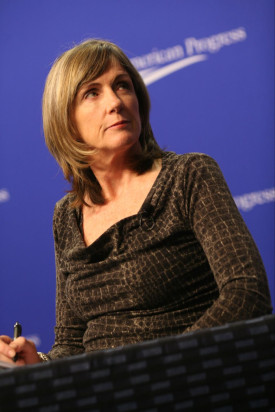
Carol Browner served as the Administrator of the EPA during the Clinton administration, from 1993-2001. The EPA is sometimes referred to as the “SHE”-PA for the role women have played in the agency. (Photo: Center for American Progress, Flickr, CC BY-N-D 2.0)
O'NEILL: So what examples have you seen of communities who are taking advantage of these opportunities that are presented in the Inflation Reduction Act?
MCCARTHY: Well, let me give you one example, Governor Mills in Maine. When this passed, she said to herself, heat pumps, I like heat pumps. In Maine, you want to have heat for everybody.
O'NEILL: Yes.
MCCARTHY: And she put not just the Inflation Reduction Act investments on the table to actually help to reduce the cost. But she put in state dollars as well. And I know that she is almost, somewhere between 90% and 100% of the homes in the great state of Maine, have heat pumps. That is a game changer. And in Massachusetts, we have a group that's been looking at, you know, a whole community organizing around every community having a heat pump, and how they could use that to provide the lowest energy costs of any community in Massachusetts. I mean, we are seeing game changers, just like that. In many of the cities across the US, we're seeing a lot of investment in solar in homes, we're seeing lots of interest, and shifts in industrial practice. So we're seeing a lot of new industries that are being created. We're seeing updates on steel, and cement factories, by looking at the opportunities that hydrogen provides to lower the emissions from those technologies. We're finding ways of reducing that pollution so that as they're producing products, they're being competitive with other countries for the lowest pollution. So there's so many exciting things that are happening.
O'NEILL: Now, March is Women's History Month. And I actually learned something recently that the EPA has a nickname, it is sometimes known as, the "She" PA. Tell us a little bit about the role that women have played historically in pushing for climate action.
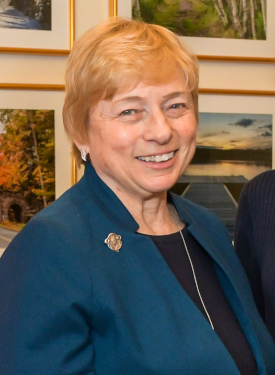
Maine Governor Janet Mills is using funding from the Inflation Reduction Act combined with state funds to install heat pumps in the vast majority of Maine homes. (Photo: Rebecca Hammel, U.S. Senate, Wikimedia Commons, Public Domain)
MCCARTHY: Well, you know, women have been historically on the mark related to the environment in general. So we do call EPA, the "She" PA. We say it with pride, and we say it in truth. You know, women have been tremendous leaders in the environmental movement and at EPA. You know, I think we all understand that Rachel Carson really set that moment. It started the environmental movement for real. And we have folks at EPA that really are following in her footsteps, you know, and it, and it wasn't a matter of whether they were Republican or Democrat. Because we had Christie Todd Whitman that came in as a Republican. She did a terrific job at EPA. You know, and we have folks like Carol Browner, who was so amazing at dealing with air quality, and pushing the envelope for cleaner and cleaner air. If not for her, we wouldn't be having these conversations about tightening PM 2.5 down to nine. I find that women don't give up. I find that they always keep their eye on the ball, which is, I need a better life for myself. I need a better job for women in general. I need to keep my kids, in the case of me, my five grandchildren. I need them to have a healthy world. That's what we fight for. But they do it collaboratively. They do it by talking to one another. They form groups together so they can be both annoying and successful at being annoying. And I just love it. If you look at, you know, communities of color, if you look at communities that are struggling with poverty, go look at who the individuals are that are leading the charge there. Go look at all of the small, you know, NGOs that have been established that are fighting the fight in environmental justice communities. You will quickly see that the vast majority of the people that are fighting this battle are women, and they're doing it for their own communities, and they're doing it all the way to the top.
O'NEILL: Gina McCarthy is the former administrator of the Environmental Protection Agency and served as the first ever White House National Climate Advisor. She's currently the Managing Co-Chair of “America Is All In”. Thank you so much for joining us today.
MCCARTHY: It was great, Aynsley. Thanks so much.
Related links:
- EPA | “Final Rule to Strengthen the National Air Quality Health Standard for Particulate Matter”
- American Lung Association | “What is Particle Pollution?”
- Read more about “America Is All In”
- Inflation Reduction Act
[MUSIC: Fred McKinnon, “America the Beautiful” on God Bless America, by Katharine Lee Bates and Samuel A. Ward, Self-published at fredmckinnon.com]
BELTRAN: Just ahead, how time in the outdoors shaped some famous women trail blazers. Keep listening to Living on Earth.
ANNOUNCER: Support for Living on Earth comes from Friends of Smeagull the Seagull and Smeagull’s Guide to Wildlife. It’s all about the wildlife right next door to you! That’s Smeagull, S - M - E - A - G - U - L - L, SmeagullGuide.org.
[CUTAWAY MUSIC: PSA Trio, Pritesh Walia, Sharik Hasan, Avery Logan “Onward” on PSA, PSA Records & Production ltd.]
Wild Girls: How the Outdoors Shaped the Women Who Challenged a Nation
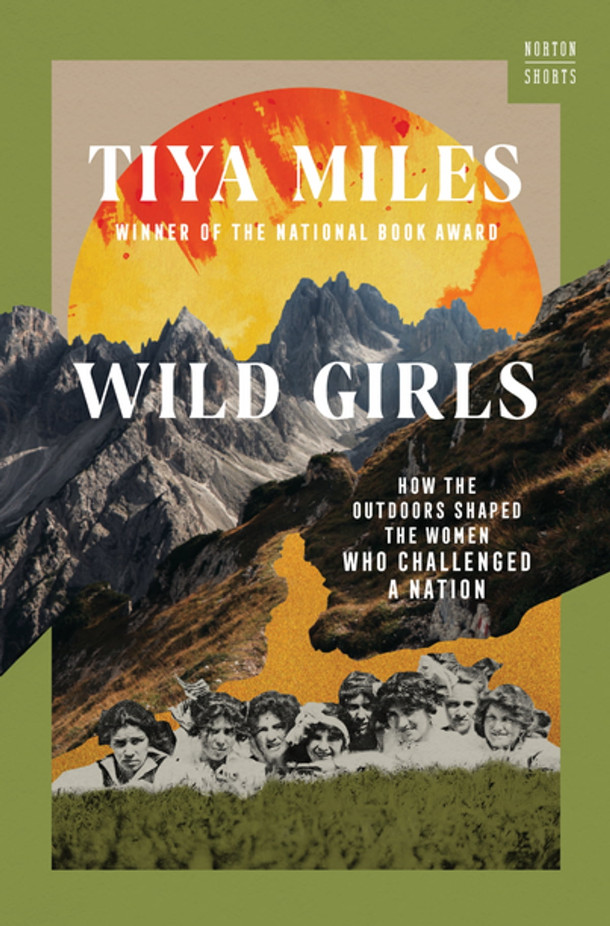
Wild Girls: How the Outdoors Shaped the Women Who Challenged A Nation (Photo: Courtesy of Tiya Miles)
O’NEILL: It’s Living on Earth, I’m Aynsley O’Neill.
BELTRAN: And I’m Paloma Beltran.
In honor of women’s history month, we turn now to the history of women outdoors in America. During the 19th century, the ability to spend time in nature helped free some girls from restrictive social norms and turned them into pioneering women. Abolitionist Harriet Tubman, novelist Louisa May Alcott, Native American writer Zitkála-Šá, and farmworkers’ champion Dolores Huerta all shared a connection to the natural world in their girlhoods. For more on these women trail blazers, we turn to historian Tiya Miles. In her book “Wild Girls: How the Outdoors Shaped the Women who Challenged a Nation”, she reveals how playing and working outside as girls prepared these women to lead the way towards gender equality, abolition, and more. Tiya recently joined me to talk about these women and I asked her to start by reading a passage from her introduction.

Zitkála-Šá, also known as Gertrude Simmons, was a member of the Yankton Dakota tribe. After a childhood spent in the wilderness, Zitkála-Šá became an author, musician, and activist. (Photo: Gertrude Käsebier, Wikimedia Commons, Public Domain)
MILES: From the micro scale of a single tree to the macro scale of the forest, spaces in nature have been meaningful to the visionary lives of American girls. Girl outsiders became trailblazers in their communities and in American culture, writ large. Time in the outdoors ignited girls’ critical awareness, fed their self-knowledge, charged their imaginations, built their capacity for resilience, and bestowed moments of inner peace that steadied their spirits and tumultuous times. The stories pressed into this book, like wildflower petals, will show how time spent outside shape the character of girls who later changed the country.
BELTRAN: Thank you. Please talk to me about the complicated social context in which these wild girls grew up in amongst the outdoors.
MILES: Well, most of the book is describing experiences that take place in the 19th century. And this was a period of extreme restriction, constriction, oppression for many different populations of girls living on these lands. It was a period as we know, of enslavement. It was a time when boarding schools, organized and funded by the federal governments were created to compel Native American, quote, education. It was a time when girls of any class at any background were expected to know their place in a sense, when it came to gendered organizations of society. So girls were supposed to be quiet, still, pure, virtuous, and obedient really, across the board in the context of American civilization.
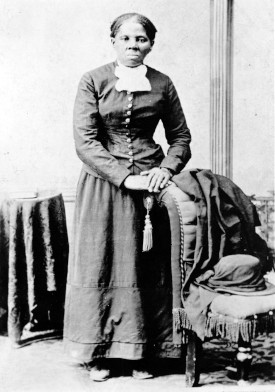
American writer, nurse, human rights activist, abolitionist, political activist and freedom fighter Harriet Tubman (Photo: Wikimedia Commons, Library of Congress, Public Domain)
BELTRAN: A moment in history that you point to is that of the Leonid Meteor shower that took place in 1833. Where thousands of meteors were seen across North America. Harriet Tubman observed that event. Can you tell us more about Harriet her story and what she witnessed that day.
MILES: Harriet Tubman was enslaved in the US South, Tubman was born in Maryland, probably in the early to mid 1820s. And she grew up in the dire-ist of circumstances. She was constantly being separated from the mother she loved, from her siblings and her father, because the man who owned her mother, and her mother's children, including Harriet Tubman, would lease them out to bring in income. So Tubman was often as a very young girl, separated from her family, alone, desperate, afraid. And as she got to become a little older and a little bolder, in part because of her experience outside, Tubman learned how to run away from the people who were leasing or renting her, and to find her mother, who was on another farm or another plantation.
BELTRAN: Tremendous bravery.
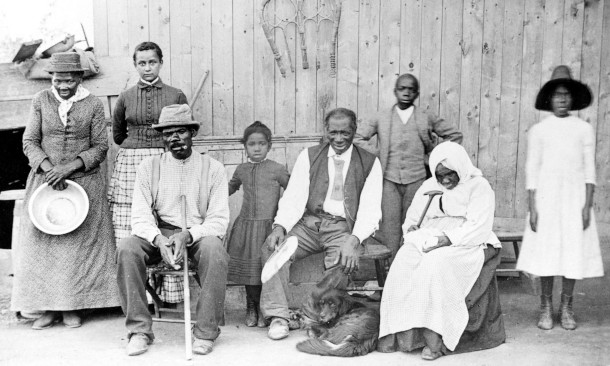
Harriet Tubman (far left) alongside members of her family and several boarders who lived in her home. (Photo: Wikimedia Commons, Public Domain)
MILES: I know, I know, it's incredible and so much courage. And one of these nights when Tubman ran away, just briefly, temporarily, to visit her mother. She was there with her brother, and they were inside the cabin where her mother lived. And her brother would stand outside at the door of the cabin, to watch for the patrollers. And these are people who would basically police the roads to look for enslaved people who might be out of their so-called rightful places without permission. And they would return these enslaved people, and they could exact terrible punishments. So Harriet Tubman as a girl, probably around the age of a tween, so a preteen was with her mother visiting and her brother was standing guard by the door, and her brother, all of a sudden shouted, "come out, come out and look at the stars". And Harriet Tubman, who at that time was known by the nickname of Minty, came outside and joined her brother. And she looked up and she saw what she later described as just an uncountable number of stars that were shooting across the sky. Harriet Tubman later said that she thought that moment could have been Judgment Day, because it was so incredible, so miraculous, to see what looked like, you know, millions or billions zillions of stars just raining down onto the earth. Well Tubman wasn't the only enslaved girl to witness this site and many other enslaved girls and boys and children saw this and remembered the story of what they often described as the night the stars fell. And in Harriet Tubman's world, and the world of enslaved girls and enslaved people, this shower seemed to carry a message. And the message was that God could possibly pass judgment on the people who are mistreating others on the earth, God could possibly pass judgment on enslavers, because God could bring the sky down in a shower of stars.
BELTRAN: How did Harriet Tubman’s experience outside help her gain the tools she needed to lead people to freedom?
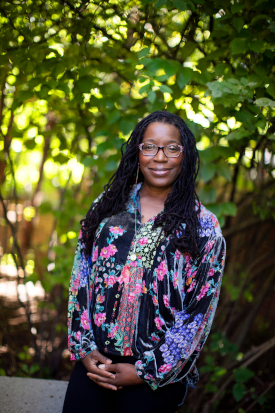
Tiya Miles is the Michael Garvey Professor of History and Radcliffe Alumnae Professor at the Radcliffe Institute for Advanced Study at Harvard University and author of Wild Girls: How the Outdoors Shaped the Women Who Challenged A Nation. (Photo: Tobi Hollander)
MILES: Spending time in nature gave Harriet Tubman psychological tools as well as the practical tools for the freedom fighter that she would become. She talked about how she was a neglected weed as a child, and these are her words. This is something that really caught my attention when I was thinking about how to interpret her life story, because it tells us that Tubman was an observer of nature. She was someone who thought nature, thought about herself through the language of nature. But it also tells us that Tubman recognized the way in which she was being mistreated as a child and she also associated herself with a kind of living thing that is incredibly tough and resilient. Tubman was a very religious woman. She believed that God was against slavery and at the same time she felt that it may have been ordained by God that she was placed outside during her teenage years to learn how to navigate the woods and learned she did. She learned about the woods, she learned how the waters flowed in the woods, she learned how to read the sky, she learned about the different animals that would be with her in the woods and when she made her escape, which would be her fine escape from slavery as a young woman she applied all of those skills. For a decade of her life following that she helped other people in the very same way, moving through those woods that she has become a companion of.
BELTRAN: And you also profiled the famous author Louisa May Alcott as one of these Wild Girls. How did Louisa's connection to nature inspire her literary work?
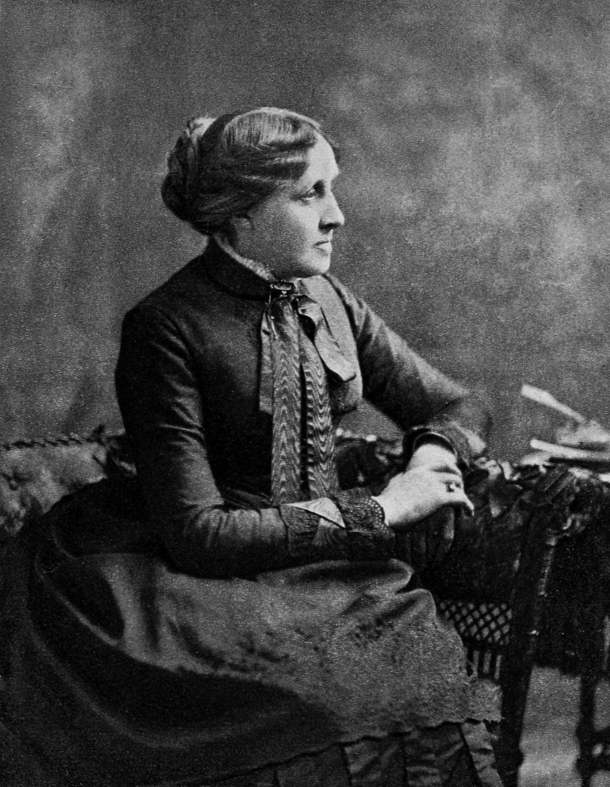
Louisa May Alcott was an American novelist, short story writer, and poet best known for writing the novel Little Women. (Photo: Wikimedia Commons, Public Domain)
MILES: Well Louisa May Alcott is a historical figure who I never really expected to research and write about Paloma. She's somebody who I read when I was a teenager, I read "Little Women" I think probably in high school or around that time and I vaguely recall enjoying the novel. But I had never thought that I would return to her. I worked on this book during the height of the COVID-19 pandemic and there was one particular weekend when my kids and I were just feeling stir crazy in the house. We needed to get out and for some reason it popped into my head "let's go to Louisa May Alcott's Orchard House". This is a historic site in Concord, Massachusetts not too far from where we live. And as I was at her home and reading about her it sort of clicked that she would've been walking these hills, she would've been planting in this garden, she would've been in a landscape where not too far away there was the very famous Walden Pond. And so I thought let me just look into this and it turns out Louisa May Alcott was a perfect figure to include in this book. I really did not know that Paloma, I had not idea the extent to which her connection to the outdoors, her sort of psychological and emotional connection, was born out of her childhood and the things she loved to do. The way she perceived herself and not just in the novel "Little Women" where we see it all over the place in the character Joe March who is a quote "tomboy". Well Louisa May Alcott was also a "tomboy" those were the words she used to describe herself and she was somebody that would say, that she didn't even want to play with a kid unless they could climb a tree, unless they liked to play with spiders the way she did. Her favorite reading spot was this old kind of wheel barrel out in the yard, she loved to go tearing across the fields. She loved to hang out with actually older men including some of the famous philosophers that we know of from Concord, Ralph Waldo Emerson, Henry David Thoreau. Louisa May Alcott I learned through my research had a really interesting way of thinking about herself. She wrote that she felt much more like a boy or a wild deer or a horse than a girl. She felt like one of these beings, these other kinds of beings who could be outside, could run outside, who could express themselves with these sort of dramatic movements all of which was supposed to be off limits for girls. I mean there's this really interesting detail that I have to slip in there…
BELTRAN: Please do!
MILES: Alcott says that when she was a girl, her mother actually tied her to the sofa to try to keep her in the house. I mean, that is, I think, the perfect symbolic image for the expectations of certain girls, especially middle class, Euro-American girls living in New England at this time. That they were supposed to be in the parlor, behaving properly, being dainty, being quiet, being pretty, being seen and not heard. But that was not who Louisa May Alcott was, she refused to be that girl. And actually, when her family moved to the country, which was Concord, her mother just seems to have given in maybe given up perhaps actually recognize and embrace the kind of kid she had. And she said Louisa May Alcott go run, and she allowed the Louisa to explore the outdoors.
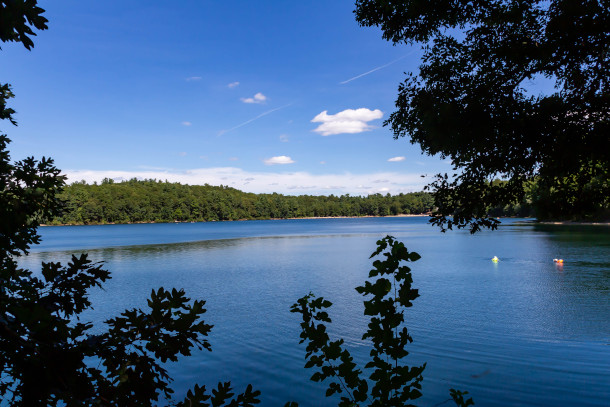
Louisa May Alcott often roamed the famous Walden Pond, a lake in Concord, Massachusetts, in the United States. (Photo by Bill Illot, Flickr, CC BY-NC-ND 2.0)
BELTRAN: Talk to me about how the multiracial spaces near Boston and Walden Pond. How did that help shape Louisa May Alcott, her writing and her spirit?
MILES: Louisa May Alcott was an unusual kid. She was an unusual girl for her family, for her society and for her time. And one time when she was doing her walkabouts, she fell into Frog Pond. And she was actually in great danger in this moment. She might have drowned. Alcott reports that it was a black boy who saved her. It was a black boy who jumped in and helped her to get out of Frog Pond. And she says from that moment, she became an abolitionist. One of the things that we see through Alcott's story and also the other stories that I tell in the book is outdoor spaces seem to make a way for people of different racial categorizations, different sex and gender categorizations, different class categorizations to come together, because they are not as heavily separated and segregated, and surveilled and policed as some of these interior spaces. So Alcott might not have come across a black boy who had that kind of freedom of movement in the town homes and country homes of her family, but the outside of the park, she did encounter him, and that encounter changed her life in more than one way. It may have actually saved her life and it certainly began a transformation in her thinking.
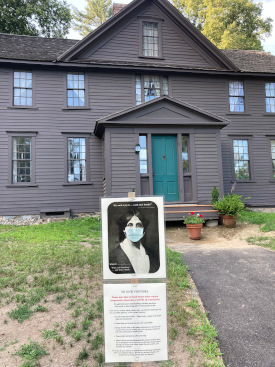
Louisa May Alcott’s historic orchard house. That is where Louisa wrote Little Women in 1868 and where the novel was set. (Photo: Tiya Miles)
BELTRAN: Tiya, what do you hope readers take away from your book and these stories?
MILES: I have heard form a number of readers, a number of women readers that the most meaningful thing to them about this book is that it reminded them of their girlhoods, it reminded them of who they were when they loved to be outside, when they loved to run through the woods to explore their neighborhoods. And it has reminded them that they want to be those same people. They want to embrace those girlhood adventures again. I so appreciate hearing that. And I would also hope that people take away a sense of inspiration about their own lives. I really do wish that people would see the examples in this book as models for what it is we can do to take care of the earth, top take care of these faces in nature and also to ensure that people have equal access to them.
BELTRAN: Tiya Miles is a Professor of History at Harvard and author of “Wild Girls: How The Outdoors Shaped the Woman who Challenged the Nation”. Tiya thank you for joining us.
MILES: I enjoyed it so much thanks Paloma.
Related links:
- Learn more about Tiya Miles
- Literary Hub | “How America’s Natural Beauty Called Generations of Women to Action”
- Purchase Tiya Mile's book Wild Girls: How the Outdoors Shaped the Women Who Challenged a Nation
[MUSIC: Chaka Khan, “I’m Every Woman” on Chaka, Warner Records Inc.]
O’NEILL: Next time on Living on Earth, the latest essay collection from National Book Award winner Ross Gay explores how we can find joy in the everyday. In The Book of (More) Delights, he reveals that everything from clotheslines to watermelon festivals to imposter syndrome shows us the beauty of life. Next week, we’ll share Ross’s unique perspective through an in-depth interview. But, for now, here’s an excerpt from his book that shows the delight to be found in the natural world:
GAY: Squirrel in a pumpkin on a porch down the block on my way, distracted from which reminded of which and I was very still. So the critter gobbled away though with an eye on me, which you could tell was really on me when looking down into the pumpkin for more goodies, looking at me, then looking down, then looking at me, then looking down, then looking at me one more time to be sure I guess I was not actually one of the neighborhood cats dressed up like a human being with a backpack before plunging headlong into the gourd. So that all that remained visible of the critter was that plump butt, those long footed rear legs and that tail buoyant flamboyant and well gaudy even gosh truth be told until popping back out of the pumpkin, eyeballing me again while working over this seed, which to the squirrel from the looks of it would be like me eating a little pizza. I'm talking scale here. This squirrel was in the plumping phase of the year, not worried about spring break. And because of my job, a lucky job as far as they go, I thought, oh, this is a delight. Let me write this down. So I elegantly swiveled my backpack into my front pack, unzipped slowly as possible, reached into the bag and as I was pulling out my notebook, the squirrel looked at me like, oh no, you don't, you cat dressed as a human and tipped away as they do, which might be a small but useful lesson on the differences or perhaps the consequences of acquiring versus being with or in or of the delight.
O’NEILL: Poet and author Ross Gay, next time on Living on Earth.
O’NEILL: Living on Earth is produced by the World Media Foundation. Our crew includes Naomi Arenberg, Josh Croom, Jenni Doering, Karen Elterman, Swayam Gagneja, Sommer Heyman, Mattie Hibbs, Mark Kausch, Mark Seth Lender, Don Lyman, Sarah Mahaney, Sophia Pandelidis, Jake Rego, El Wilson, and Jolanda Omari.
BELTRAN: A special thanks to Quentin Bell for his time. Tom Tiger engineered our show. Alison Lirish Dean composed our themes. You can hear us anytime at L-O-E dot org, Apple Podcasts and Google Podcasts, and like us, please, on our Facebook page - Living on Earth. We tweet from @livingonearth. And find us on Instagram at livingonearthradio. And you can write to us at comments at loe dot org.
Steve Curwood is our Executive Producer. I’m Paloma Beltran.
O’NEILL: And I’m Aynsley O’Neill. Thanks for listening!
ANNOUNCER: Funding for Living on Earth comes from you, our listeners, and from the University of Massachusetts, Boston, in association with its School for the Environment, developing the next generation of environmental leaders. And from the Grantham Foundation for the protection of the environment, supporting strategic communications and collaboration in solving the world’s most pressing environmental problems.
ANNOUNCER 2: PRX.
Living on Earth wants to hear from you!
Living on Earth
62 Calef Highway, Suite 212
Lee, NH 03861
Telephone: 617-287-4121
E-mail: comments@loe.org
Newsletter [Click here]
Donate to Living on Earth!
Living on Earth is an independent media program and relies entirely on contributions from listeners and institutions supporting public service. Please donate now to preserve an independent environmental voice.
NewsletterLiving on Earth offers a weekly delivery of the show's rundown to your mailbox. Sign up for our newsletter today!
 Sailors For The Sea: Be the change you want to sea.
Sailors For The Sea: Be the change you want to sea.
 The Grantham Foundation for the Protection of the Environment: Committed to protecting and improving the health of the global environment.
The Grantham Foundation for the Protection of the Environment: Committed to protecting and improving the health of the global environment.
 Contribute to Living on Earth and receive, as our gift to you, an archival print of one of Mark Seth Lender's extraordinary wildlife photographs. Follow the link to see Mark's current collection of photographs.
Contribute to Living on Earth and receive, as our gift to you, an archival print of one of Mark Seth Lender's extraordinary wildlife photographs. Follow the link to see Mark's current collection of photographs.
 Buy a signed copy of Mark Seth Lender's book Smeagull the Seagull & support Living on Earth
Buy a signed copy of Mark Seth Lender's book Smeagull the Seagull & support Living on Earth

